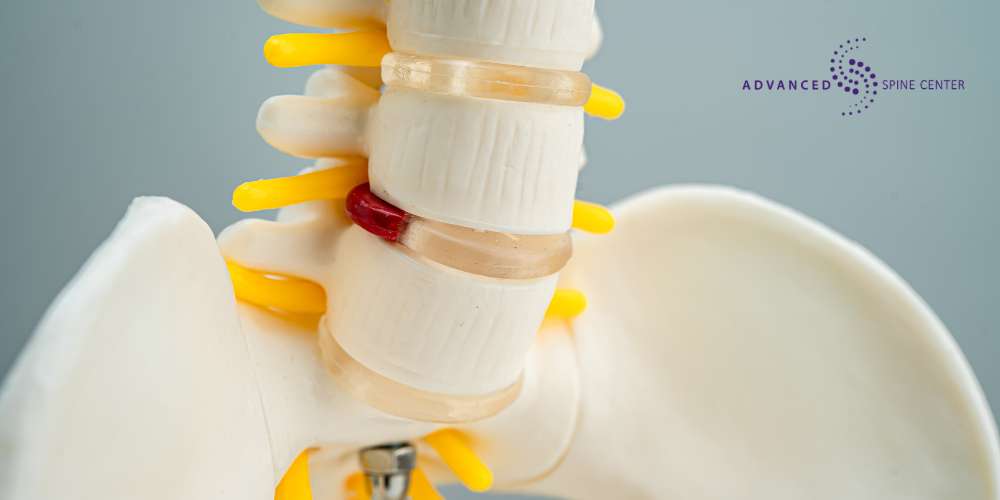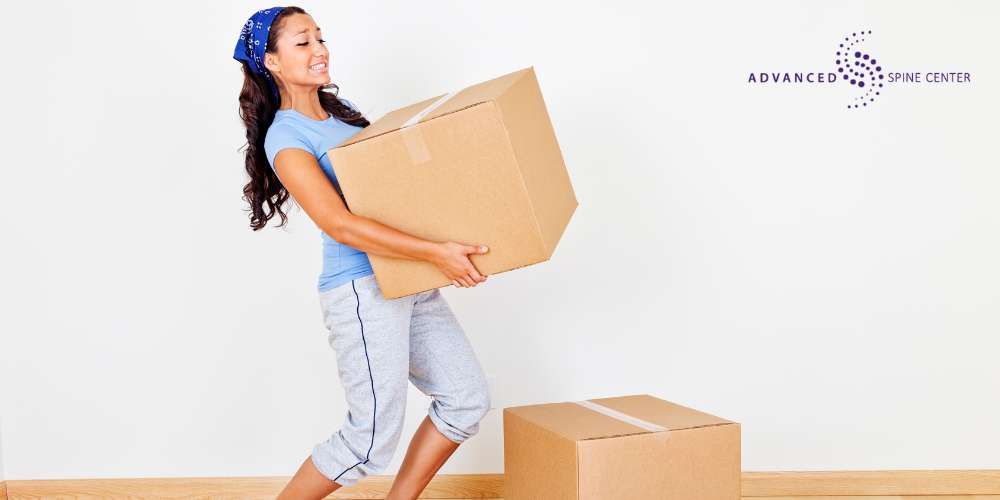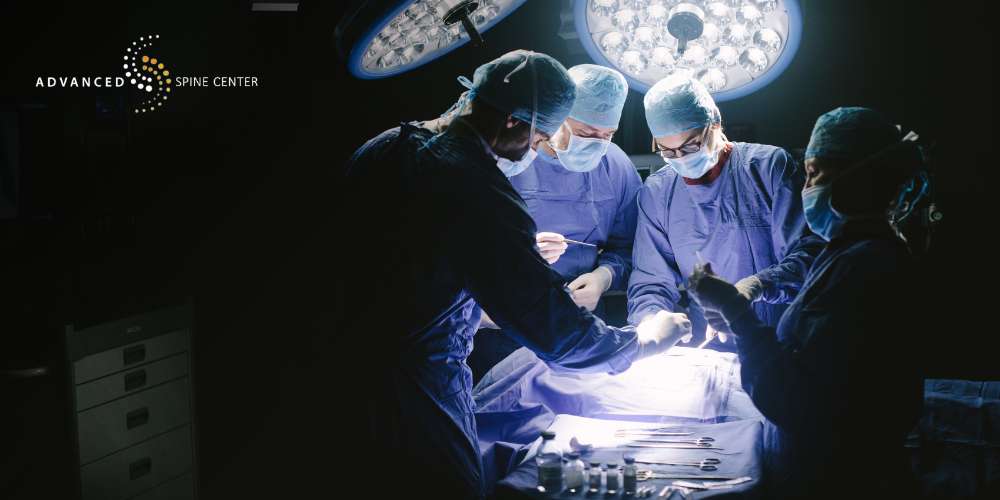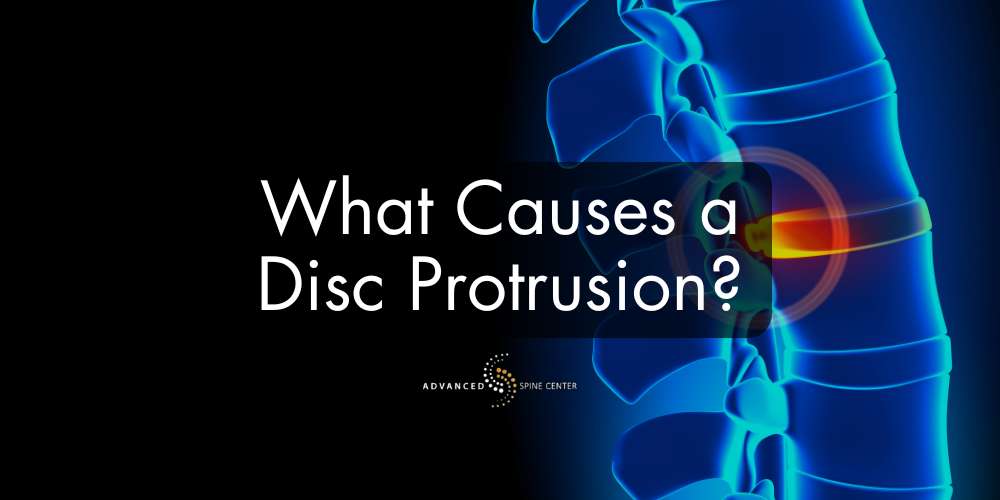Experiencing Pain from a Disc Protrusion or Bulging Disc?
A disc protrusion is a condition affecting the spinal disc, a cushion-like structure between the vertebrae in your spinal column, that develops when the disc material pushes beyond its normal boundary. Many factors can lead to this protrusion, ranging from everyday wear and tear to a traumatic injury that causes the nucleus to break in the intervertebral disc, leading to a herniation of the disc material.
At Advanced Spine Center in Plano, TX, we address back pain and disc disease every day. We help patients understand that disc protrusions often occur as a result of poor posture, repetitive movements, or a physically demanding job.
If you are suffering from back pain, radiating pain, or leg pain affecting your ability to walk, you might be experiencing symptoms from a disc protrusion or a bulging disc. The pain can be severe and may include numbness, difficulty walking, and muscle weakness.
Seeking help for these symptoms early is important because once a disc protrusion occurs, the risk factors for further injury increase, and the healing process may become more challenging without proper treatment options.
Take charge of your spinal health by calling the Advanced Spine Center at (972) 499-5457 today. Speak with fellowship-trained orthopedic spine surgeon Dr. Stephen Courtney to discuss your symptoms and explore personalized treatment options that can help you live pain-free.
What Is a Disc Protrusion?

A disc protrusion is a condition where the spinal disc bulges outward from its normal disc circumference without completely breaking through the annulus fibrosis, the ring-like structure that protects the nucleus pulposus.
In a disc protrusion, the intervertebral disc’s structure remains mostly intact even though the disc material is pushed out. This is why most patients experience back pain and sometimes radiating pain in the leg muscles. The disc, acting as a shock absorber, is designed to handle stress; however, a disc protrusion occurs when repetitive movements or a traumatic injury overloads its capacity.
In addition, the term disc protrusion is used interchangeably with the term protruding disc, and both describe a scenario where the disc is deformed but has not completely ruptured. When you are diagnosed with a disc protrusion through imaging such as MRI, the report may mention that a disc protrusion occurs near the spinal canal, which might be compressing the nerve root or even the spinal cord. This distinction is important for planning treatment options, including physical therapy and, in some cases, spine surgery.
Disc Protrusion vs Disc Herniation
The difference between a disc protrusion and a disc herniation lies in the extent of disc material displacement. In a disc protrusion, the disc bulge is contained by the annulus fibrosus, while in a herniated disc, the nucleus breaks through the outer layers and may leak out.
This means that a herniated disc is usually associated with more severe pain and nerve involvement compared to a disc protrusion. Patients with a herniated disc often experience leg pain, numbness, and muscle weakness, and the condition may require a more aggressive treatment approach than a disc protrusion.
Disc Extrusion vs Protrusion
A disc extrusion is a more advanced form of disc protrusion where the disc material extends beyond the disc circumference but may still be connected to the disc. Although both conditions affect the spinal disc, disc extrusion often results in more pronounced symptoms such as severe pain, radiating pain, and compressed nerve roots.
The distinction between disc extrusion and protrusion is important for determining the treatment options, which can range from pain medication and bed rest to physical therapy and, if necessary, surgical intervention.
Disc Protrusion Symptoms

Common symptoms of a disc protrusion can vary in intensity, ranging from mild discomfort to severe pain that interferes with daily activities and quality of life.
Patients with a disc protrusion may experience the following symptoms:
- Persistent Back Pain: Pain in the back that often intensifies with movement or poor posture.
- Radiating Pain: Pain that extends from the lumbar region into the leg muscles and sometimes the affected leg.
- Numbness: A sensation of reduced feeling or tingling in the leg or foot due to nerve compression.
- Muscle Weakness: Weakness in the affected leg resulting from the pressure on the nerve root.
- Difficulty Walking: Challenges with walking, which can be a sign that the bulging disc is compressing the nerve root.
- Neck Pain (in some cases): When the protrusion occurs in the cervical spine, it may result in pain in the neck.
Patients may notice that a bulging disc occurs suddenly after a physically demanding job or a traumatic injury. Alternatively, the condition may develop gradually over time due to degenerative disc disease.
Types of Disc Protrusions
Several types of disc protrusions can affect different areas of the spine. Whether the protrusion is central or paracentral, subarticular or foraminal, each type impacts the spinal disc and surrounding structures differently. Understanding these variations helps in selecting the proper treatment options and clarifying the prognosis for the healing process and recovery.
Central Disc Protrusion
A central disc protrusion is located in the middle of the disc and often affects the spinal canal, potentially compressing the spinal cord. This type of disc protrusion can cause back pain and may also lead to radiating pain if the compressed nerve root sends signals of numbness or muscle weakness. Although central disc protrusions can be serious, many patients find relief through a combination of physical therapy and pain medication before considering spine surgery.
Paracentral Disc Protrusion
A paracentral disc protrusion occurs off to one side of the center of the disc and can lead to symptoms similar to a herniated disc. Patients with this condition often report leg pain, difficulty walking, and a protrusion that occurs in the lumbar disc. The intervertebral disc herniation in a paracentral location may compress the nerve root on one side, which explains why symptoms are often more pronounced on one side of the body compared to the other.
Subarticular Disc Protrusion
A subarticular disc protrusion is situated just beneath the facet joints of the vertebrae. This type of disc bulge can cause localized back pain and may lead to a tear in the annulus fibrosus. Because the subarticular area is adjacent to the nerve root, even a slight disc herniation can result in radiating pain or numbness in the leg muscles. Early treatment with physical therapy and good posture can help manage the symptoms and prevent the condition from worsening.
Foraminal Disc Protrusion
A foraminal disc protrusion occurs at the opening where nerve roots exit the spinal canal. This protrusion can compress the nerve root, leading to leg pain, numbness, and muscle weakness. Since the disc in the foraminal area is a critical structure in the spinal column, any protrusion here requires prompt evaluation. Treatment options often begin with conservative measures like physical therapy, pain medication, and adopting healthy habits to support the spine.
What Can Cause a Disc Protrusion?

Various causes can contribute to the development of a disc protrusion. Repetitive movements, poor posture, and a physically demanding job can all gradually wear down the spinal disc, eventually leading to a disc bulge or protruding disc. Traumatic injury, such as a fall or a car accident, can also precipitate a disc herniation, where the disc material is forced out of position. In some cases, degenerative disc disease may weaken the disc structure over time, making it more prone to disc protrusion.
Degenerative Disc Disease
Degenerative disc disease is one of the most common causes of disc protrusion. Over time, the spinal disc loses its shock absorption capacity due to the gradual breakdown of the annulus fibrosus and nucleus pulposus. This deterioration leads to a disc bulge and sometimes a disc extrusion when the intervertebral disc herniation is more advanced. Patients with degenerative disc disease are often advised to adopt good posture and engage in regular physical therapy to help manage back pain and delay further degeneration.
Traumatic Spine Injuries
A traumatic injury, such as those sustained in an accident or sports incident, can cause a sudden disc protrusion. When a disc experiences excessive force, the nucleus pulposus may bulge outward, leading to a herniated disc or even a slipped disc. The resulting back pain and radiculopathy can be severe, and the intervertebral disc may become compressed, leading to radiating pain down the leg. Prompt evaluation and early treatment options are critical to prevent long-term damage to the spinal cord and nerve roots.
Lifestyle Choices
Lifestyle choices, including poor posture and a lack of exercise, can contribute significantly to the development of a disc protrusion. When the back muscles are weak, the spinal disc is forced to bear a greater load, which may lead to a bulging disc or even disc extrusion over time.
Maintaining healthy habits, such as regular physical therapy exercises and practicing good posture, can reduce the risk factors that commonly occur with disc protrusions. In some cases, risk factors like repetitive movements and a physically demanding job further increase the chances of developing a disc herniation.
Disc Protrusion Treatment in Plano, TX

At Advanced Spine Center in Plano, TX, we offer a comprehensive evaluation of your disc condition, whether it is a disc protrusion, bulging disc, or even a herniated disc. Our treatment options for disc protrusion range from conservative management, including physical therapy and pain medication, to surgical intervention when necessary. We assess the severity of the disc herniation, paying close attention to whether a central disc protrusion is causing compression of the spinal cord or nerve root to decide if spine surgery might be needed.
Physical Therapy for Disc Protrusion
Physical therapy is one of the primary treatment options for a disc protrusion. Through targeted exercises, physical therapy helps strengthen the back muscles, improve shock absorption, and support the spinal disc to reduce back pain. For patients with a bulging disc or even a herniated disc, regular sessions can alleviate radiating pain and promote the healing process without resorting immediately to surgery. Many patients experience improvement in symptoms such as poor posture and difficulty walking after committing to a structured physical therapy regimen.
Disc Protrusion Surgery
For some patients, disc protrusion may require spine surgery if conservative treatments do not relieve the back pain or if the disc is severely compressed and affects the spinal cord. Spine surgery for disc protrusion, which may include a discectomy, is considered when the disc herniation leads to severe pain, muscle weakness, or numbness in the affected leg.
Surgical intervention is recommended only after exhausting non-invasive treatment options such as physical therapy, pain medication, and bed rest. Restoring proper disc function and alleviating pressure on the nerve root is paramount to reducing long-term complications.
Contact the Advanced Spine Center for Disc Protrusion and Herniated Disc Treatments in Plano

If you are experiencing persistent back pain, radiating pain, or any symptoms associated with a disc protrusion or bulging disc, our team at Advanced Spine Center is here to help. We focus on comprehensive care for disc herniation, lumbar disc herniation, and other spinal disc issues, offering treatment options that range from physical therapy and pain medication to surgery when necessary.
Our approach focuses on addressing the protrusion and the underlying factors that contribute to disc disease and a bulge in the spinal disc. We work closely with each patient to develop healthy habits, improve good posture, and reduce the repetitive movements that may lead to further injury. By treating the disc, vertebrae, and surrounding back muscles, our treatment options help prevent additional risk factors and provide relief from pain that commonly occurs with disc protrusions.
At Advanced Spine Center, we believe in providing personalized care for every patient. We understand that a disc protrusion can significantly impact your daily life, from difficulty walking to severe pain that interferes with work and personal activities. With our commitment to your healing process and a thorough evaluation of your spinal disc condition, our center in Plano is dedicated to helping you achieve long-term relief and a better quality of life.
Do not let a disc left untreated affect your quality of life—call us today at (972) 499-5457 or contact us online to schedule an appointment and begin the healing process.










